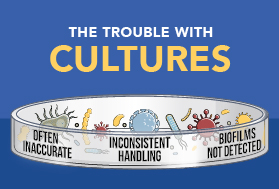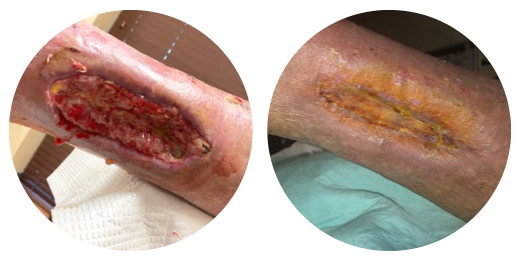The Limitations of Culture
When using culture, a lack of anaerobe and fungal detection impairs outcome

Anaerobes constitute up to 49% of bacteria in infected wound beds. Adhesion, antiphagocytic factors, and the expression of tissue-damaging exoenzymes are some of the ways anaerobes impair healing. Synergistic pathogenicity detected between aerobic and anaerobic bacteria further emphasizes the importance of anaerobe detection.
Fungal communities are predictive of healing time, associated with poor outcomes, and form mixed fungal-bacterial biofilms. Based on over 76,000 wound samples processed at MicroGenDX, fungi have been detected in 8.8% of chronic wounds.
Culture not recommended for biofilm bacteria detection
Conventional culture assesses free-floating populations of a single species and lacks the sensitivity to identify bacteria within complex polymicrobial communities.
Biofilm growth also increases the fitness of bacteria in harsh conditions. Bacteria from clinical biofilms can exhibit impaired growth in culture, even when the species involved are readily culturable and permissive conditions are used. Read more about biofilms
Antimicrobial susceptibility vs. resistance genes
In a polymicrobial infection, enhanced antimicrobial resistance through cross-species synergistic relationships results in C&S single bacterium susceptibility becoming irrelevant to treatment decision-making.
qPCR+NGS resistance gene identification reflects such synergistic relationships, and is not hindered by differentiated gene expressions observed in vivo versus in vitro or by the presence of drug-resistant subpopulations. qPCR+NGS more accurately represents the resistance potential of the entire bio-community and is much more useful for treatment decision-making.
“Biofilm-growing microorganisms are significantly more tolerant to antibiotics and corresponding breakpoints have not been established. The SI-R results can therefore not be used to predict therapeutic success in the case of biofilm infections and offer no guide to clinicians for treating such infections.” – ESCMID guideline for the diagnosis and treatment of biofilm infections
Culture vs. molecular testing sensitivity comparison
In a study of 168 chronic wounds 17 bacterial species were identified using culture – compared to 338 with molecular testing. Why does this matter? Because without knowing the complete microbial picture, the patient can be at risk for serious complications. Read study
References
- Penterman J, Nguyen D, Anderson E, et al. Rapid evolution of culture-impaired bacteria during adaptation to biofilm growth. Cell Rep. 2014;6(2):293‐300. doi:10.1016/j.celrep.2013.12.019
- Høiby, N. et al. ESCMID guideline for the diagnosis and treatment of biofilm infections 2014. Clinical Microbiology and Infection. 2015; 21(1): S1-S25. DOI:https://doi.org/10.1016/j.cmi.2014.10.024
- Fungi in wound samples: data on file
- G. Bowler, B. I. Duerden,and D. G. Armstrong. Wound Microbiology and Associated Approaches to Wound Management. Clin Microbiol Rev. 2001 Apr; 14(2): 244–269. doi: 10.1128/CMR.14.2.244-269.2001
- Mette Burmølle, Jeremy S. Webb, Dhana Rao, Lars H. Hansen, Søren J. Sørensen, Staffan Kjelleberg. Enhanced Biofilm Formation and Increased Resistance to Antimicrobial Agents and Bacterial Invasion Are Caused by Synergistic Interactions in Multispecies Biofilms. APPLIED AND ENVIRONMENTAL MICROBIOLOGY, June 2006, p. 3916–3923 Vol. 72, No. 6 0099-2240/06/$08.000 doi:10.1128/AEM.03022-05
- Daniel D. Rhoads 1,2, Randall D. Wolcott 1,3,4,*, Yan Sun 3 and Scot E. Dowd. Comparison of Culture and Molecular Identification of Bacteria in Chronic Wounds. Int. J. Mol. Sci. 2012, 13, 2535-2550; doi:10.3390/ijms13032535
- Diabetic leg wound internal case study: data on file

